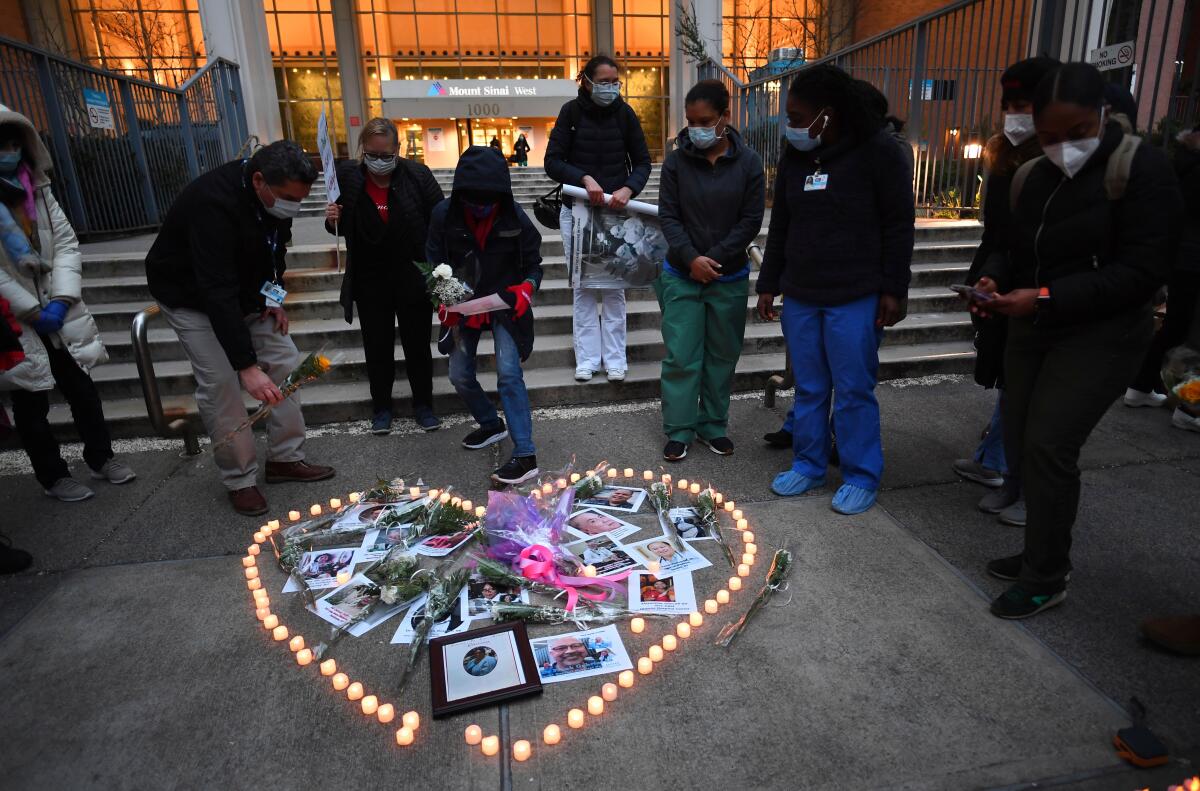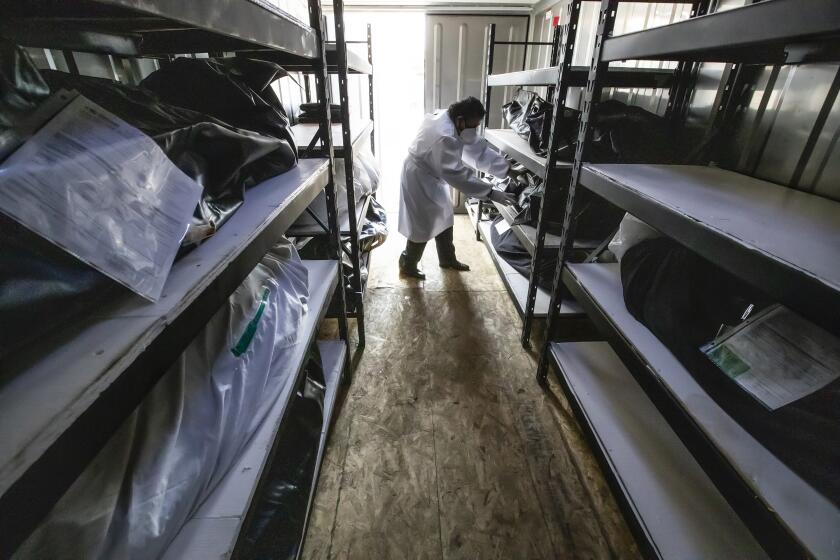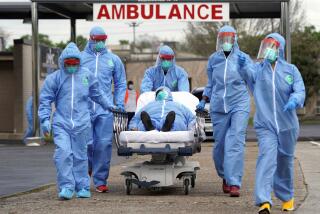More than 200,000 people have died of COVID-19 in the U.S.

- Share via
COVID-19 deaths in the U.S. surpassed 200,000 on Tuesday, as outbreaks of the disease flare in little-touched parts of the country and authorities brace for a rising caseload with the onset of autumn.
The death toll, logged by researchers at Johns Hopkins University, was at more than 200,550 by Tuesday afternoon, the highest of any country in the world by far. It comes as the U.S. economy falters, scientists race to come up with a vaccine and Americans prepare to vote Nov. 3 in a bitterly contested presidential election.
Over the course of eight bleak months, the virus scythed its way through vibrant metropolises and quiet farming communities alike, leaving almost no corner of the country untouched. The nation’s elderly have borne the brunt of the pandemic, but the disease has taken its toll in every age group, with Black people and Latinos suffering disproportionately.
Even public health experts struggled to fathom the scale of loss.
“The idea of 200,000 deaths is really very sobering, and in some respects stunning,” Dr. Anthony Fauci, the government’s top expert on infectious diseases, said on CNN.
The true toll, public health experts say, is almost certainly higher. Particularly in the pandemic’s early days, many deaths were blamed on other causes.
Since the first U.S. deaths were recorded in February, the country has registered nearly 6.9 million cases, or more than one-fifth of the global total of about 31.4 million. Americans account for about the same proportion of COVID-19 deaths worldwide.
The virus has claimed as many American lives as the country’s last five wars combined. COVID-19 as a cause of death in the United States is now surpassed only by heart disease, according to the University of Washington’s Institute for Health Metrics and Evaluation.
The U.S. death toll — 200,000 — from the coronavirus has passed the total from WWI and the Vietnam War combined. Here’s a look at COVID-19’s place in history.
In a nod to past national trauma, the pandemic’s toll is often compared to that of the terrorist attacks of Sept. 11, 2001 — 67 times over. The accretion of deaths is comparable to the entire populations of American cities such as Little Rock, Ark., or Salt Lake City.
Paralleling the growing human toll, economic carnage has mounted. Unemployment hit levels not seen since the Great Depression as businesses closed or struggled to stay afloat, and consumers stayed home. The federal government approved a coronavirus relief package worth more than $3 trillion, but efforts to bolster that with more aid foundered amid partisan acrimony.
For millions of Americans, the mundane rhythms of pre-pandemic life — school, the office, day care — have been replaced by a frantic scramble to care for the kids and pay the bills. The lucky can work at home; essential workers — nurses and bus drivers, firefighters and supermarket cashiers — must navigate a public realm fraught with dread and danger.
About 1 of every 13 deaths from COVID-19 in the U.S. has occurred in California, which had recorded at least 15,143 deaths as of Tuesday. That is less than half the number of coronavirus-related fatalities in New York, which remains the hardest-hit state.
Amid fear of contagion in hospitals, even the American way of death has undergone a sea change. Untold numbers of patients have died in the company of masked medical personnel, with no loved ones at hand. Families of the stricken sob into smartphones, hoping their words of love and consolation can be heard. The bereaved do their grieving via videoconference.
The pandemic’s relentless progression has become deeply entangled with the nation’s political life, and the 200,000 death mark comes six weeks before the presidential election. President Trump’s handling of the outbreak will be on the minds of many voters, with critics accusing him of blatant untruthfulness, willful negligence and consistently undermining experts’ public health guidance.
Trump told a Detroit television station on Tuesday that his administration has done an “amazing” job in fighting the coronavirus.
At the White House, Press Secretary Kayleigh McEnany denied that Trump had ever misled the public about the gravity of the outbreak. Asked whether Trump had expressed remorse or sympathy over the scale of death, McEnany said: “The president throughout this pandemic has done just that.”
More loss lies ahead. With the onset of colder weather, as people retreat indoors to what may be poorly ventilated spaces, some models forecast the death toll could double by the year’s end. Prospects for a widely available vaccine are considered scant for 2020, but likelier next year.
In the spring, early outbreaks pummeled densely populated states including New York and New Jersey. Summer saw a surge of cases in the South and West. Now new trouble spots are emerging in the country’s midsection, in states such as Montana and North Dakota.
From a watching world, the landmark American toll elicits astonishment and pity. The country’s vast wealth and resources, its scientific expertise and a flawed but highly sophisticated healthcare system seemed to afford little protection.
As the U.S. outbreak was first taking hold, 200,000 deaths seemed to many an excessively pessimistic forecast. Trump predicted on April 10 that the toll would stay beneath 100,000; that tally was marked less than seven weeks later, on May 27.
Over the months of spreading contagion, American life has assumed a bizarre split-screen quality: While many people are scrupulous mask-wearers and social distancers, others jeer at face coverings as an infringement on their liberties. To a degree echoed in few U.S. peer countries, trust in public health guidance became a barometer of political leanings.
Fauci, in his CNN interview, was asked how people could get information they could trust about the virus.
“They need to get it by following the scientific data, and the scientific evidence,” he said.
More to Read
Sign up for Essential California
The most important California stories and recommendations in your inbox every morning.
You may occasionally receive promotional content from the Los Angeles Times.












